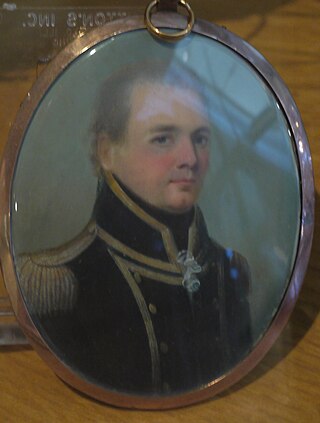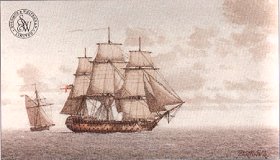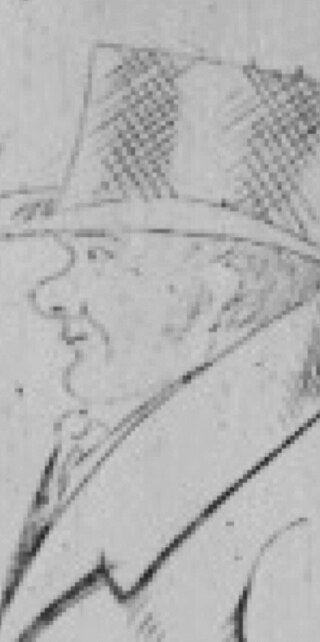Related Research Articles

The Battle of Trafalgar was a naval engagement that took place on 21 October 1805 between the British Royal Navy and the combined fleets of the French and Spanish Navies during the War of the Third Coalition of the Napoleonic Wars (1803–1815).
Eight ships of the Royal Navy have been named HMS Pickle:

HMS Royal Sovereign was a 100-gun first-rate ship of the line of the Royal Navy, which served as the flagship of Admiral Collingwood at the Battle of Trafalgar. She was the third of seven Royal Navy ships to bear the name. She was launched at Plymouth Dockyard on 11 September 1786, at a cost of £67,458, and was the only ship built to her design. Because of the high number of Northumbrians on board the crew were known as the Tars of the Tyne.

Sir John Thomas Duckworth, 1st Baronet, GCB was an officer of the Royal Navy, serving during the Seven Years' War, the American War of Independence, the French Revolutionary and Napoleonic wars, as the Governor of Newfoundland during the War of 1812, and a member of the British House of Commons during his semi-retirement. Duckworth, a vicar's son, achieved much in a naval career that began at the age of 11.
HMS Pickle was a topsail schooner of the Royal Navy. She was originally a civilian vessel named Sting, of six guns, that Lord Hugh Seymour purchased to use as a tender on the Jamaica station. Pickle was at the Battle of Trafalgar, and though she was too small to take part in the fighting, Pickle was the first ship to bring the news of Nelson's victory to Great Britain. She also participated in a notable single-ship action when she captured the French privateer Favorite in 1807. Pickle was wrecked in 1808, but without loss of life.

The International Fleet Review was the most recent Royal Navy review, continuing a tradition going back to the 15th century. It took place on 28 June 2005, as part of the Trafalgar 200 celebrations to commemorate the 200th anniversary of the Battle of Trafalgar in 1805. For the celebrations to mark Her Majesty's Diamond Jubilee in 2012, instead of a Fleet Review such as marked that of Queen Victoria, there was a cavalcade of boats down the Thames.

Andrew Lambert is a British naval historian, who since 2001 has been the Laughton Professor of Naval History in the Department of War Studies, King's College London.

Captain John Richards Lapenotière was a British Royal Navy officer who, as a lieutenant commanding the tiny topsail schooner HMS Pickle, observed the Battle of Trafalgar on 21 October 1805, participated in the rescue operations which followed it and then carried the dispatches of the victory and the death of Admiral Nelson to Britain.
Commander Robert Benjamin Young, RN was an officer in the Royal Navy. His service in small ships led to his presence observing the battle of Trafalgar in 1805 from the deck of the tiny 10-gun cutter HMS Entreprenante. Following this battle, Young performed well, acting as messenger and rescue boat during the storm, although the honour of carrying the dispatches back to England was given to John Richards Lapenotiere, commander of HMS Pickle; Young maintained that prior to the battle Admiral Nelson had promised this honour to him.

HMS Edgar was a 74-gun third-rate ship of the line of the Royal Navy, that saw service in the American Revolutionary, French Revolutionary and Napoleonic Wars. Launched in 1779, she fought in the battles of Cape St Vincent and Copenhagen, two of the major naval engagements of the wars.
The 1805 Club was founded in 1990 to accomplish three objectives. To assist in the preservation of monuments and memorials relating to Vice- Admiral Lord Horatio Nelson and seafarers of the Georgian era. To promote research into the Royal Navy of the Georgian period, and especially of Vice Admiral Lord Nelson. To organize cultural and historical events.

Rear-Admiral Samuel Sutton was an officer in the Royal Navy. He entered the service shortly after the start of the American War of Independence, and spent most of his early career serving with Captain and later Admiral Joshua Rowley. He saw action at several engagements with the French fleets in the West Indies, and ended the war as a lieutenant. Left without active employment by the following years of peace, Sutton briefly returned to service during the Spanish Armament in 1790, but the outbreak of the French Revolutionary Wars in 1793 brought him steady work. After serving in a number of ships and being present at Cornwallis's Retreat in 1795, Sutton received command of a sloop, and with it the opportunity to render a service to a member of the French aristocracy, and the future Charles X of France. Promoted for his good service, Sutton served as a flag captain to several admirals, including Horatio Nelson. He briefly commanded HMS Victory, before surrendering her to Thomas Hardy, who would go on to command Victory at Trafalgar, and be present at Nelson's death. Sutton instead took command of a frigate, and in 1804 was involved in a controversial action that saw the capture of three Spanish frigates and the destruction of a fourth. Made wealthy from the spoils, Sutton nevertheless remained in the navy, taking part in the chase of the French fleet to the West Indies in 1805. His health declined during this period, and he went ashore in October that year. He retired from active service, and served as a magistrate and local official for his community, being promoted to rear-admiral in 1821 and dying in 1832.

Admiral of the Fleet Sir George Martin was an officer of the Royal Navy who saw service during the American War of Independence, and the French Revolutionary and Napoleonic Wars. During his long naval career he took part in several significant battles, for which he was awarded a number of honours and promotions; he commanded ships at Cape St Vincent and Cape Finisterre.
Sir John Lawford was an officer of the Royal Navy who served during the American War of Independence and the French Revolutionary and Napoleonic Wars.
Brian Lavery, is a British naval historian, author, and Curator Emeritus at the National Maritime Museum, Greenwich, London, England.
Peter Goodwin is a British maritime historian and author, and the former Keeper and Curator of HMS Victory.

This Bibliography covers sources for Royal Navy history through the 18th and 19th centuries. Some sources may be duplicated in sections when appropriate. Among the contemporary and earlier historical accounts are primary sources, historical accounts, often derived from letters, dispatches, government and military records, captain's logs and diaries, etc., by people involved in or closely associated to the historical episode in question. Primary source material is either written by these people or often collected, compiled, and/or written and published by other editors also, sometimes many years after the historical subject has passed. Primary sources listed in this bibliography are denoted with an uppercase bold ' (P) before the book title. Publications that are in the public domain and available online for viewing in their entirety are denoted with E'Book.

The British Baltic Fleet and also known as the Baltic Squadron was a series of temporary or semi permanent fleets of the Royal Navy. They were assembled at Spithead a naval anchorage in the English Channel for various naval operations in the Baltic Sea from 1658 to 1856 commanded by the Commander-in-Chief, Baltic Fleet.
William Cuming (1760–1824) was an officer in the Royal Navy who served during the American and French Revolutionary Wars. He was the captain of HMS Russell at the Battle of Copenhagen in 1801, where his men captured the Danish ship of the line Prøvesteenen. In 1805, as flag captain aboard HMS Prince of Wales, he returned to England for Robert Calder's court martial, following perceived inaction at the Battle of Cape Finisterre. Cuming, therefore, missed the Battle of Trafalgar.
References
- ↑ Peter Hore Historian
- ↑ RHS members
- ↑ Peter Hore retires as CEO
- ↑ Author Peter Hore recognised
- ↑ HMS Sydney Book Review
- ↑ Reading List - HMAS Sydney
- ↑ "Sir Robert Craven Trophy". Journal of the Britannia Naval Research Association (Volume 5 no. 3 page 67) carries details of the first ten awardees and their citations for research by the Britannia Nautical Research Association at Oxford
- ↑ Warships International Fleet Review Editorial staff
- ↑ Dunlop, Samuel Clarke (1922–2008)
- ↑ Le Bailly, Sir Louis Edward Stewart Holland (1915–2010)
- ↑ Tippet, Sir Anthony Sanders (1928–2006)
- ↑ Peter Hore biographies
- ↑ Peter Hore Bibliography
- ↑ 1805 Club council member profiles